When it comes to planning and cultivating a thriving garden, one of the key considerations is understanding the lifespan of the plants you choose. Hostas, with their lush foliage and vibrant hues, stand as perennial favorites among garden enthusiasts. In this comprehensive guide, Gina Farm delve into the fascinating question that often arises: Are Hostas Perennials or Annuals?
Are Hostas Perennials or Annuals?
Hostas are popular perennial plants known for their attractive foliage and adaptability to various garden conditions. Let’s decode the nature of hostas by exploring their key characteristics, care requirements, and some interesting facts:
Foliage:
- Hostas are primarily grown for their foliage, which comes in a wide range of shapes, sizes, and colors. The leaves can be heart-shaped, lance-shaped, or oval.
- Colors vary from deep green to blue-green, chartreuse, gold, and variegated combinations.
- Some hosta varieties have textured or ribbed leaves, adding visual interest.
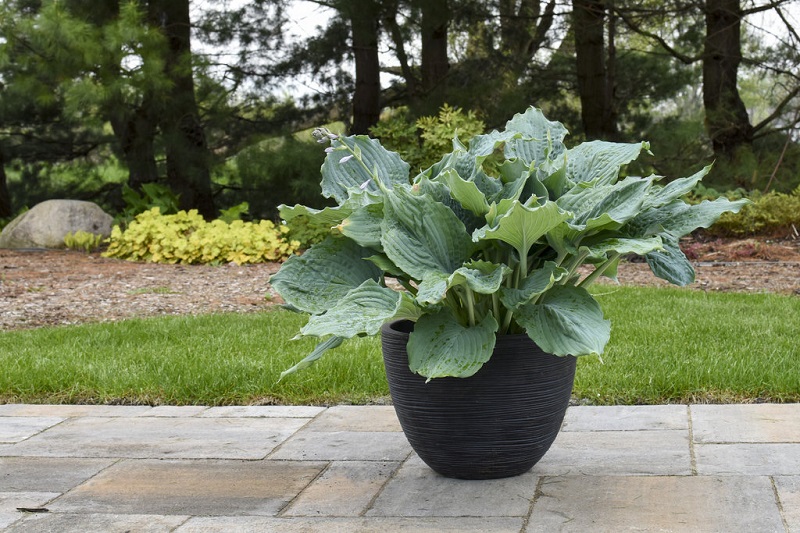
Size:
Hostas come in various sizes, from small, compact varieties to large, sprawling ones. Some miniature hostas are perfect for container gardening, while larger ones make excellent ground cover.
Flowers:
Although hostas are mainly grown for their foliage, they also produce flowers. The blooms are usually on tall, slender stems and come in shades of white or lavender.
Some gardeners remove the flower stems to redirect the plant’s energy into foliage development.
Growing Conditions:
Hostas are shade-loving plants, but they can tolerate varying degrees of sunlight. Generally, they prefer partial to full shade, especially in hotter climates.
Well-draining, rich soil is ideal for hostas. They thrive in soils amended with organic matter.
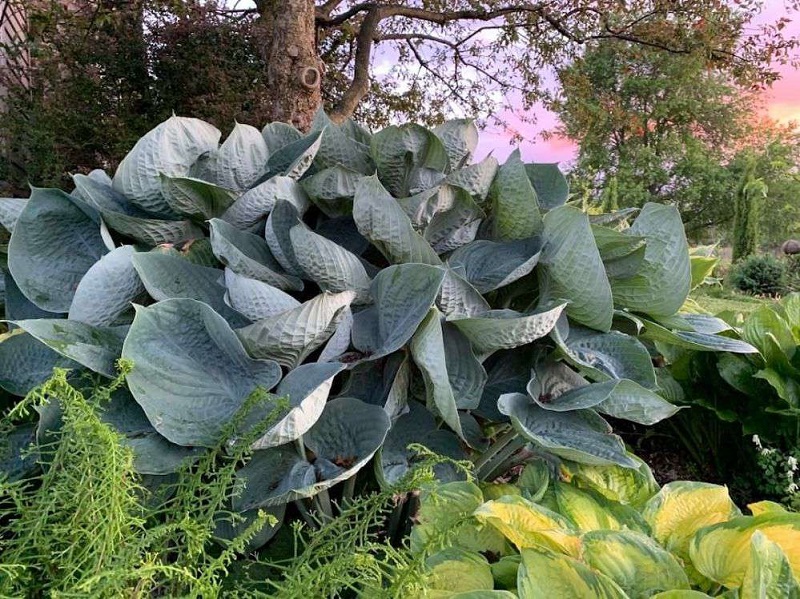
Watering:
- Hostas prefer consistent moisture but should not be waterlogged. Regular watering is essential, especially during dry spells.
- Applying a layer of mulch around the plants helps retain soil moisture and regulates soil temperature.
Maintenance:
- Hostas are relatively low-maintenance plants. Removing spent flower stems and old, yellowing leaves can help improve the plant’s appearance.
- Slug and snail control may be necessary, as these pests are attracted to the lush foliage. Copper barriers, diatomaceous earth, or organic slug baits are common methods for control.
Division:
- Hostas benefit from division every few years to maintain their vigor. Dividing the clumps also allows you to propagate new plants.
- Spring or early fall is the best time for division.
Hardiness:
Hostas are hardy plants and can withstand cold temperatures. However, their hardiness varies depending on the species and variety.
Companion Plants:
Hostas work well with a variety of shade-loving companion plants, such as ferns, astilbes, and heucheras, creating visually appealing shade gardens.
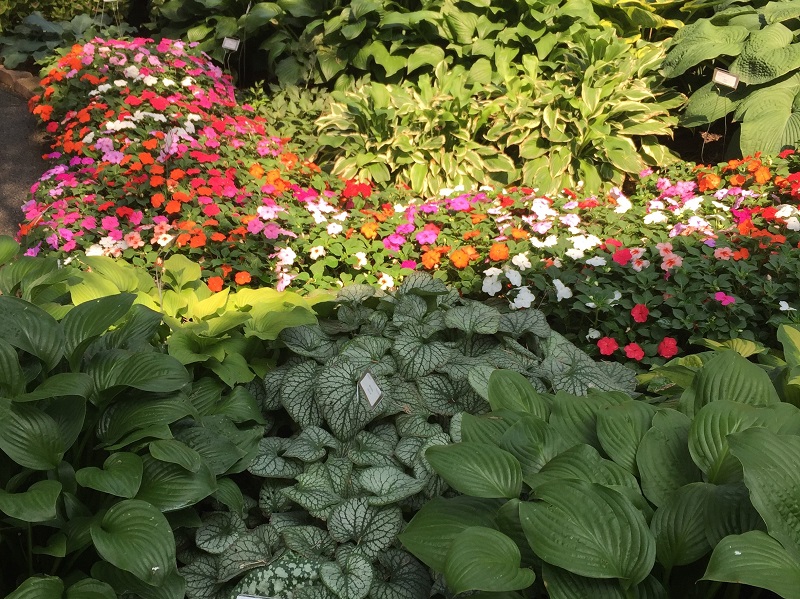
Interesting Facts:
- The scientific name for hosta is Hosta plantaginea, and it belongs to the family Asparagaceae.
- Hostas are native to Asia, particularly China, Korea, and Japan.
- The name “hosta” honors Austrian botanist Nicholas Thomas Host.
Understanding these aspects of hostas can help you create a thriving garden with these versatile and beautiful plants. Whether you’re a seasoned gardener or a beginner, hostas can be a rewarding addition to your landscape.
Understanding the Growth Seasons of Hostas
Hostas, like many perennial plants, go through distinct growth seasons. Understanding these seasons can help you care for your hostas more effectively and enjoy their beauty throughout the year. The growth seasons of hostas generally follow a pattern:
Spring Growth:
- Emergence: Hostas typically start their growth in early spring as they emerge from the ground. The new shoots, often referred to as “eyes” or “noses,” unfurl into leaves.
- Leaf Development: During spring, the focus is on leaf development. The leaves expand and take on their characteristic shapes and colors.
- Flower Stems: Some hosta varieties produce flower stems in late spring. These stems rise above the foliage and bear clusters of flowers.
Summer Growth:
- Foliage Maturity: By early to mid-summer, the hosta foliage is usually at its peak, displaying the full range of colors and patterns.
- Blooms: If your hostas have flowered, you’ll enjoy the blossoms during this season. While the foliage remains the main attraction, the flowers add a delicate touch to the overall appearance.
Fall Transition:
- Fading Blooms: As summer transitions to fall, the hosta flowers begin to fade. Some gardeners choose to deadhead (remove spent flowers) to encourage the plant to focus on foliage growth.
- Preparing for Dormancy: In preparation for winter, hostas start storing energy in their rhizomes (underground stems) and roots. The foliage may begin to show signs of aging, turning yellow or brown.
Dormancy:
- Winter Rest: Hostas go dormant in winter. The above-ground parts of the plant, including the leaves, die back. The plant essentially rests during this period.
- Mulching: Applying a layer of mulch around the base of the hostas in late fall helps insulate the soil, protecting the plant during winter.
Late Winter to Early Spring (Next Year):
Spring Awakening: As winter wanes, hostas prepare for a new growth season. In late winter to early spring, you might see the first shoots emerging from the ground, signaling the start of a new cycle.

Tips for Each Season:
- Spring: Keep an eye on emerging shoots, and ensure the soil is well-drained. If you’ve divided or transplanted hostas, this is the best time.
- Summer: Regular watering is crucial during hot spells. Mulching helps retain soil moisture and keeps the roots cool.
- Fall: Continue watering until the ground freezes. Remove dead or yellowing foliage to tidy up the garden.
- Winter: Minimal care is needed during winter, but providing a layer of mulch can be beneficial, especially in colder climates.
By understanding the growth seasons of hostas, you can time your care practices appropriately, ensuring your plants thrive and contribute to a vibrant garden throughout the year.
Addressing Common Misbeliefs About Hostas
Hostas are popular and versatile plants, but there are some common misconceptions or myths associated with them. Let’s address and clarify these misbeliefs:
Hostas Only Thrive in Shade:
Clarification: While hostas are known for their preference for shade, many varieties can tolerate varying degrees of sunlight. Some hostas actually thrive in partial to full sun, though they generally prefer dappled or filtered shade. It’s essential to consider the specific needs of the hosta variety you’re growing.
Hostas Do Not Flower:
Clarification: Hostas do produce flowers, typically in late spring to early summer. However, the primary attraction of hostas is their foliage, and the flowers may not be as showy as those of other plants. Some gardeners even prefer to remove the flower stalks to redirect the plant’s energy into foliage development.
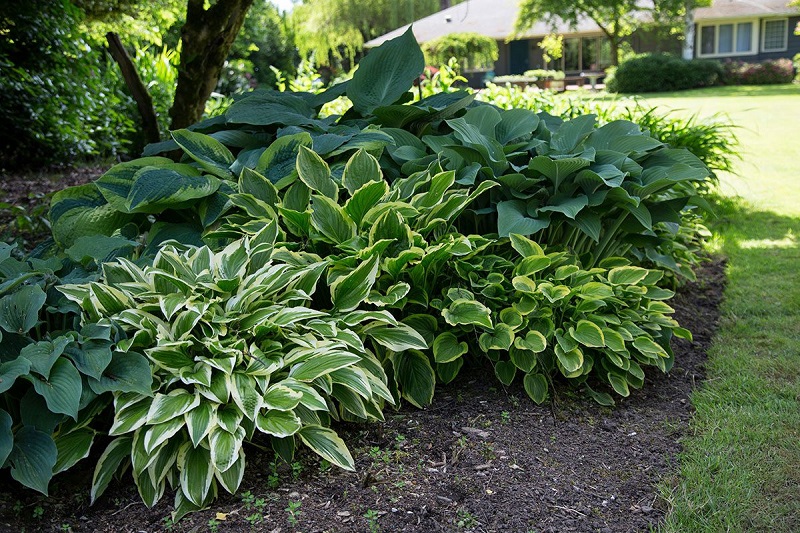
Hostas Are High-Maintenance Plants:
Clarification: Hostas are generally considered low-maintenance plants. While they benefit from some care, such as watering, mulching, and occasional division, they are not overly demanding. Once established in a suitable environment, hostas can thrive with minimal intervention.
Hostas Are Prone to Pest Problems:
Clarification: While hostas can attract pests like slugs and snails, it doesn’t mean they are exceptionally prone to pest problems. Many pest issues can be managed through various methods, such as using organic slug baits, copper barriers, or creating a barrier of diatomaceous earth around the plants.
Hostas Are Slow to Establish:
Clarification: Hostas are known for their adaptability and can establish themselves relatively quickly, especially in favorable growing conditions. While they might take a season or two to reach their full potential, they are not exceptionally slow growers.
Hostas Need Constant Division:
Clarification: While hostas benefit from occasional division to maintain vigor and control size, they do not require constant division. Dividing every three to five years is generally sufficient, and some well-maintained hosta clumps can thrive for many years without division.
All Hostas Look the Same:
Clarification: Hostas come in a wide variety of sizes, shapes, and colors. The range of leaf shapes, sizes, and colors is extensive, from small and compact varieties to large, striking ones. There is considerable diversity among hostas, making them suitable for various garden styles.
Hostas Are Deer-Resistant:
Clarification: While some hosta varieties may be less appealing to deer, there is no guarantee that hostas are entirely deer-resistant. In areas with a high deer population, additional measures may be necessary to protect hostas, such as using deer repellents or installing physical barriers.

Understanding the true nature of hostas can help gardeners make informed decisions about their care and placement in the landscape, dispelling common myths associated with these popular plants.
Planting Hostas: Tips for Long-Term Success
Planting hostas can be a rewarding endeavor, as these versatile and attractive plants can add beauty to your garden. Here are some tips for long-term success when planting hostas:
Choose the Right Location:
- Hostas generally prefer partial to full shade, though some varieties can tolerate more sunlight. Select a location with well-drained soil that is rich in organic matter.
- Consider the mature size of the hosta variety you’re planting to ensure it has enough space to spread and thrive.
Soil Preparation:
- Work organic matter, such as compost or well-rotted manure, into the soil before planting. This improves drainage and provides essential nutrients.
- Hostas prefer slightly acidic to neutral soil with a pH range of 6.0 to 7.5.
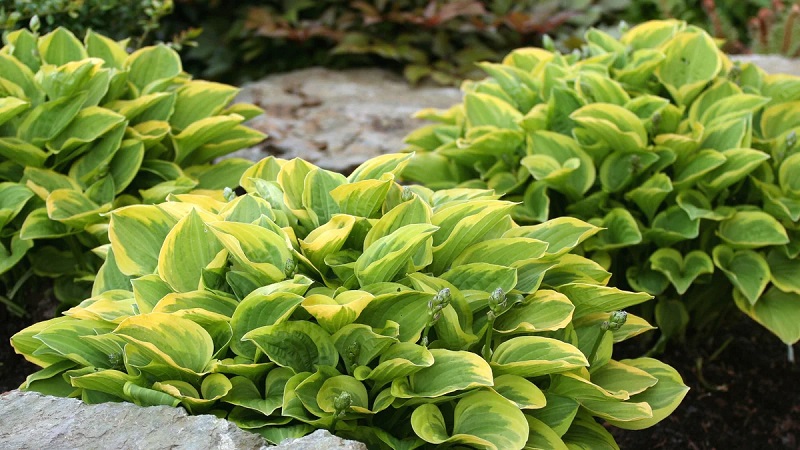
Planting Depth:
- Plant hostas at the same depth they were growing in their nursery pots. The crown (where the leaves meet the roots) should be at or slightly above the soil surface.
- Planting too deeply can lead to crown rot, while planting too shallowly may expose the roots to drying.
Spacing:
- Space hostas according to their mature size. This not only allows for proper air circulation but also prevents overcrowding as the plants grow.
- Small varieties may need about 12 to 18 inches of space, while larger ones may require 24 inches or more.
Watering:
- Provide regular watering, especially during dry spells. Hostas like consistent moisture but should not be waterlogged.
- Water at the base of the plant to keep the foliage dry, which can help prevent diseases.
Mulching:
- Apply a layer of organic mulch, such as shredded bark or compost, around the base of the hostas. Mulch helps retain soil moisture, regulates temperature, and suppresses weeds.
- Mulching also provides a buffer against extreme temperatures.
Fertilizing:
- Hostas are not heavy feeders, but they benefit from a balanced, slow-release fertilizer in spring as new growth emerges.
- Avoid over-fertilizing, as this can lead to excessive foliage at the expense of overall plant health.
Divide Hostas as Needed:
- Over time, hostas can become crowded, leading to reduced vigor and size. Dividing the clumps every three to five years rejuvenates the plants.
- The best times to divide hostas are in early spring as new growth emerges or in early fall.
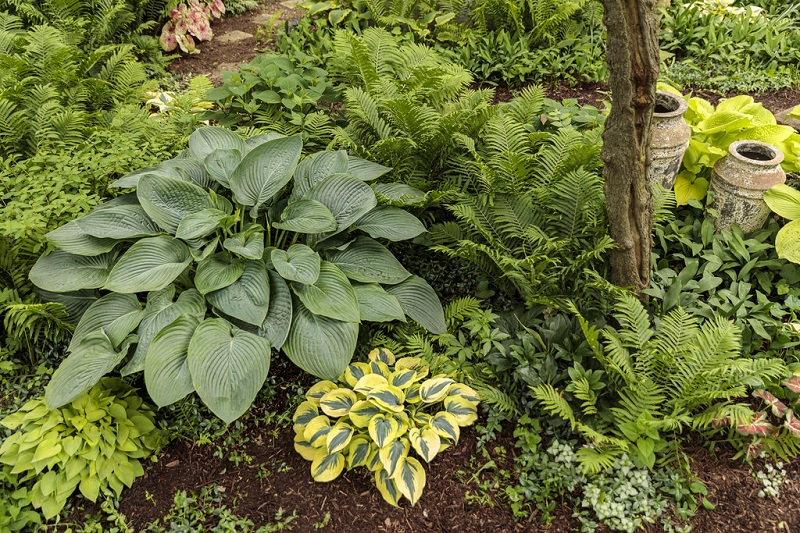
Pest and Disease Management:
- Keep an eye out for pests such as slugs and snails, which are attracted to hosta foliage. Use organic pest control methods or barriers to protect your plants.
- Good air circulation and proper watering practices can help prevent diseases like leaf spot and crown rot.
Winter Care:
- In colder climates, apply a layer of mulch around the base of hostas in late fall to insulate the soil and protect the plants during winter.
- Remove dead foliage in the fall to tidy up the garden and prevent disease issues.
By following these tips, you can establish healthy and thriving hostas that will enhance your garden for years to come.
Final Thoughts: The Everlasting Charm of Hostas
In conclusion, the question Are Hostas Perennials or Annuals? finds its unequivocal answer in the perennial category. Hostas, with their enduring nature and captivating beauty, enrich your garden season after season.
As you embark on the journey of cultivating these perennial wonders, remember that understanding their growth cycle and providing optimal care are the keys to a flourishing garden. Embrace the allure of hostas, and let your garden thrive with the timeless beauty of these beloved perennials.